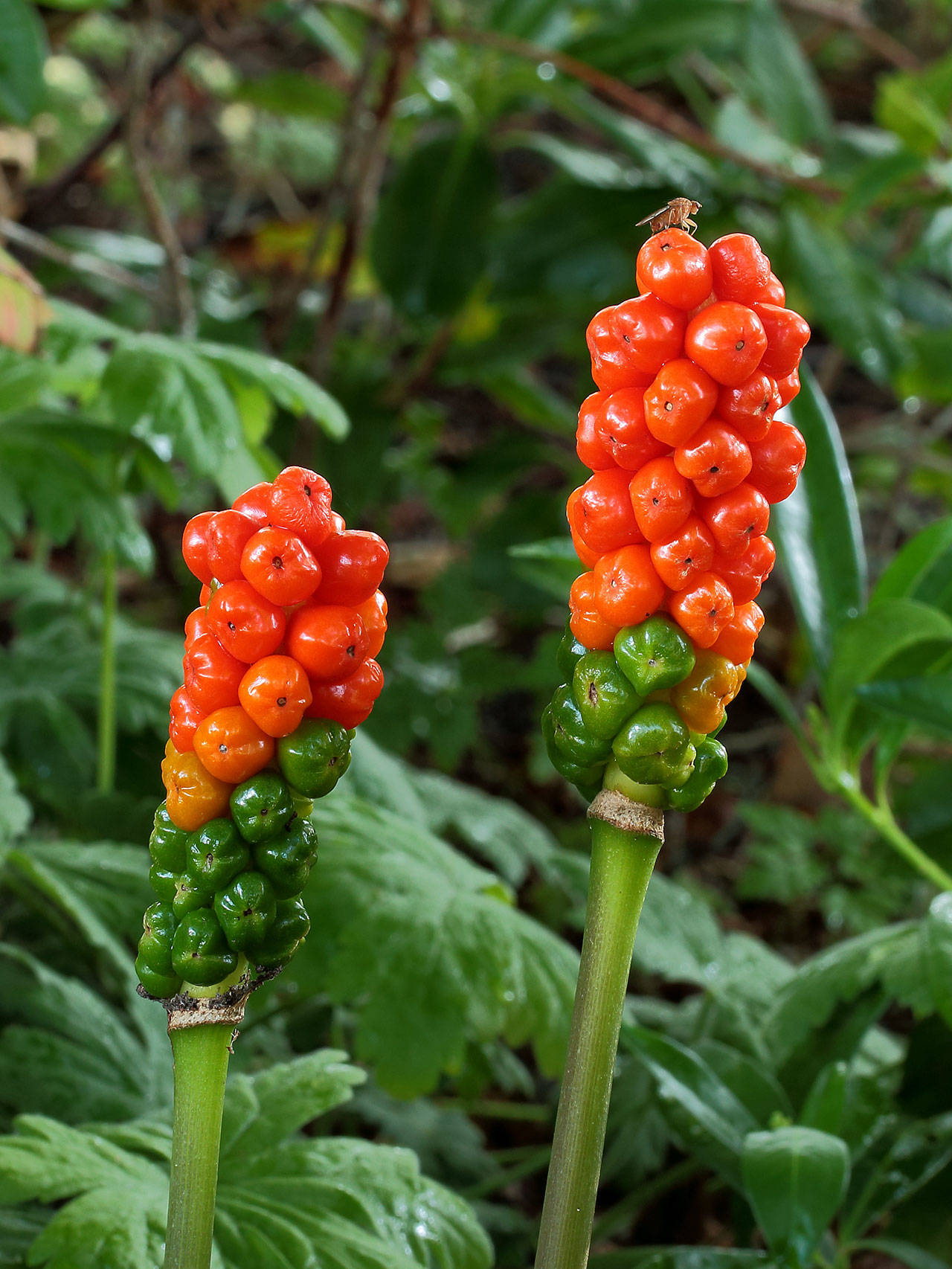Submitted by San Juan County Noxious Weed Control Program
Few may know Italian arum by name, but this non-native perennial’s distinctive appearance stands out in a crowd. Its glossy, triangular leaves often exhibit a marbled pattern, with lush foliage that may conjure up the image of early Biblical clothing. Come spring, a large, showy flower appears with a pale green, hooded spathe (a leaf modified to wrap around the actual flowers) and a long spadix (a spike with small flowers, like a miniature corncob), together giving one the impression of Elvis with his fine capes and big collars.
Some find the odor of this inflorescence to be unpleasant, with one blogger likening it to “rotten teeth breath.” Others are reminded of feces or stale urine. This has the effect of attracting flies, beetles or midges as pollinators, which is a trait shared with other members of the arum family (Araceae), including our native skunk cabbage. After bloom, typically coinciding with drier weather in our county, Italian arum’s leaves wither and die back, leaving exposed the fruits—initially green, then ripening to red-orange—together arising like some fiery scepter from the devil’s own hand. By fall, late winter or early spring, its leaves reappear, often before other plants leaf out. These early leaves may be oval-shaped and without white markings.
No ban yet exists for Arum italicum, which originates from portions of Asia, northern Africa, and Europe. It is still sold widely in the U.S. as a garden ornamental. Italian arum is on Washington State’s noxious weed list (Class C, control recommended) because it is extremely good at reproducing itself, to the point that it begins to take more than its fair share of space. It is also very hard to control, once established. Arum menaces native plant communities and may suppress native pollinators by reducing their preferred native forage. With the prospect of birds eating the berries and aiding its spread, arum’s capacity to alter fragile ecosystems is a growing concern. According to the State Weed Board, it has already managed to naturalize in several counties, and its rate of spread appears to be accelerating.
Italian arum is also toxic, containing needle-like calcium oxalate crystals which confer protection from herbivores. Grazers unschooled in its chemistry are likely to suffer injuries to the mouth, tongue, throat, and even skin, according to the written findings of the Washington State Noxious Weed Control Board.
Attempts at manual control have proven highly frustrating, thanks to its ability to generate numerous underground tubers, some the size of a fingerling potato, others as small as a pea (the “daughter” tubers). Upon digging up a clump of arum, one may get the bulk of tubers out, but inevitably, a few of the tiny daughters remain behind. In summer, arum’s “contractile” roots actually pull the tubers deeper into the soil, making a successful removal that much more elusive.
Prevention is the best solution: do not buy, sell or trade it. If you already have arum, and you choose to dig it out, dispose of all plant parts in bags or containers, including ripe fruits. Avoid tossing plants on compost piles or waste areas, as they readily re-root. Given how difficult it can be to find every tuber, some may even dispose of the soil (bagged). So if you happen to see Italian arum for sale at a nursery, avoid the embrace of this would-be lover with rotten teeth breath, before it’s too late.
For more information contact 376-3499 or jasono@sanjuanco.com.




